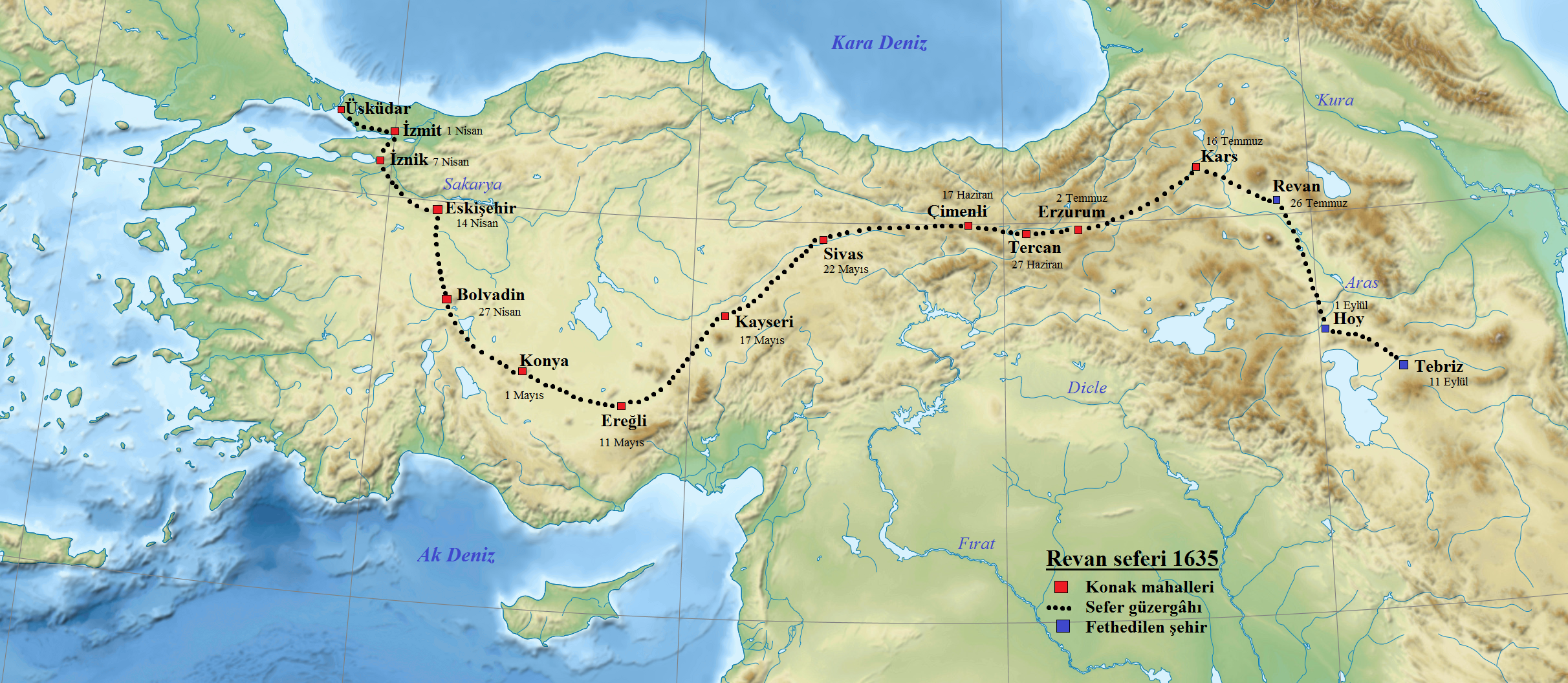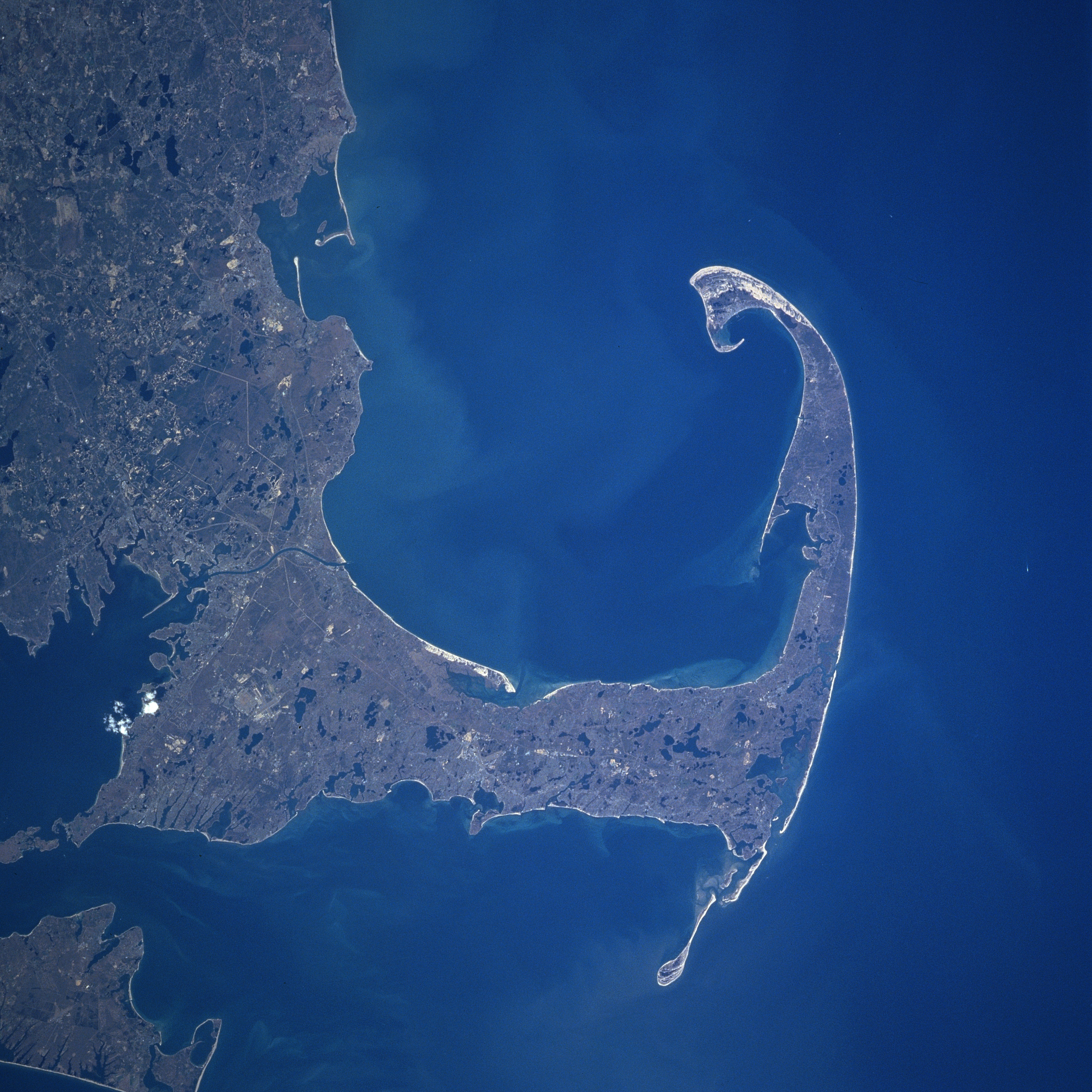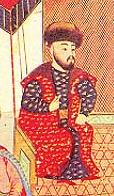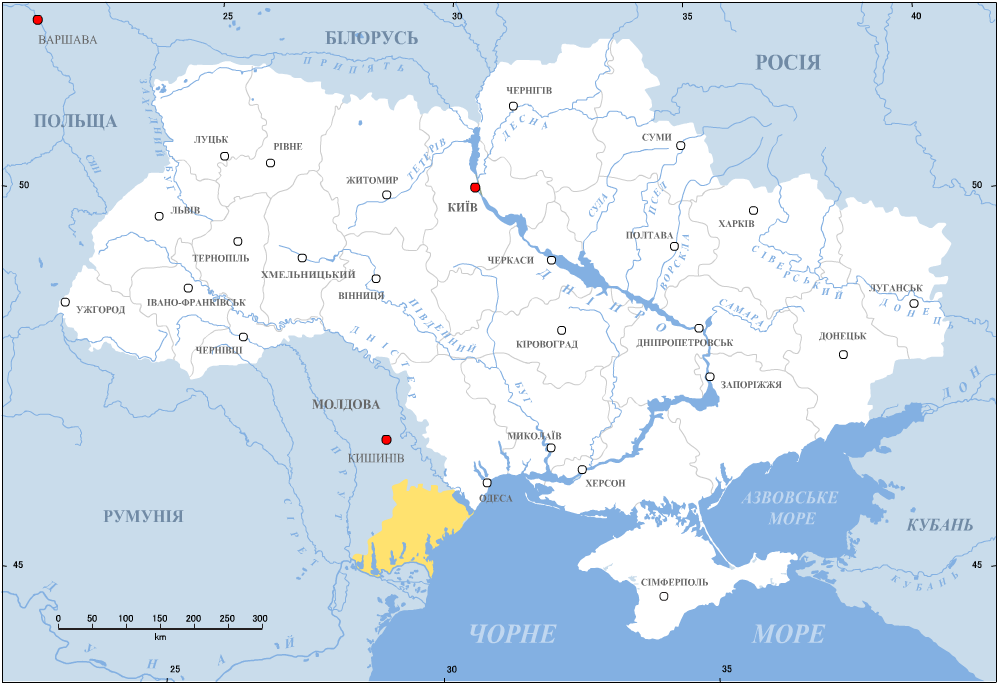|
Bahadır I Giray
Bahadır I Giray Crimean Tatar, Ottoman Turkish and (1602–1641, reigned 1637–1641) was a khan of the Crimean Khanate. Much of his reign was spent dealing with Azov which had been captured by the Cossacks. He died from wounds or illness while returning from the failed Azov campaign in 1641. He was the father of Selim I Giray and, through him, the ancestor of all khans who reigned after 1700 except for Devlet III. Early life and enthronement He was the son of Selâmet I Giray who reigned from 1608 to 1610. During his father's reign he was sent to Turkey as a ‘rekhin’ or honorable hostage. He grew up on an estate near Yambol. He was described as handsome, learned, eloquent and something of a poet. In June 1637 the Turks deposed İnayet Giray and placed Bahadir on the throne. As kalga and nureddin he chose the brothers Islyam and Safa Girai. Just after coming to the throne he learned that the Don Cossacks had captured Azov. Reign and Azov problem Azov, or Azak as it was t ... [...More Info...] [...Related Items...] OR: [Wikipedia] [Google] [Baidu] |
Crimean Tatar Language
Crimean Tatar (), also called Crimean (), is a Turkic languages, Turkic language spoken in Crimea and the Crimean Tatar diasporas of Uzbekistan, Turkey and Bulgaria, as well as small communities in the United States and Canada. It should not be confused with Tatar language, Tatar, spoken in Tatarstan and adjacent regions in Russia; Crimean Tatar has been extensively influenced by nearby Oghuz languages and is mutually intelligible with them to varying degrees. A long-term ban on the study of the Crimean Tatar language following the deportation of the Crimean Tatars by the Soviet government has led to the fact that at the moment UNESCO ranks the Crimean Tatar language among the languages under serious threat of extinction (''severely endangered''). However, according to the A. Yu. Krymskyi Institute of Oriental Studies, Institute of Oriental Studies, due to negative situations, the real degree of the threat has elevated to critically endangered in recent years, which are highl ... [...More Info...] [...Related Items...] OR: [Wikipedia] [Google] [Baidu] |
Ottoman–Safavid War (1623–1639)
The Ottoman–Safavid War of 1623–1639 was a conflict fought between the Ottoman Empire and Safavid Iran, then the two major powers of Western Asia, over control of Mesopotamia. After initial Safavid success in recapturing Baghdad and most of modern Iraq, having lost it for 90 years, the war became a stalemate as the Safavids were unable to press further into the Ottoman Empire, and the Ottomans themselves were distracted by wars in Europe and weakened by internal turmoil. Eventually, the Ottomans were able to recover Baghdad, taking heavy losses in Capture of Baghdad (1638), the final siege, and the signing of the Treaty of Zuhab ended the war in an Ottoman victory. Roughly speaking, the treaty restored the borders of Peace of Amasya, 1555, with the Safavids keeping Safavid Daghestan, Daghestan, Safavid Shirvan, Shirvan, eastern History of Georgia (country), Georgia, and Eastern Armenia, while western Georgia and Western Armenia decisively came under Ottoman rule. The eastern ... [...More Info...] [...Related Items...] OR: [Wikipedia] [Google] [Baidu] |
1602 Births
Events January–March * January 3 – Battle of Kinsale: The English defeat Irish rebels and their Spanish allies. (The battle happens on this date according to the Gregorian calendar used by the Irish and Spanish but on Thursday, 24 December, 1601 according to the old Julian calendar used by the English.) * February 2 (Candlemas night) – In London, the first known production of William Shakespeare's comedy ''Twelfth Night'' takes place. * March 20 – The Dutch East India Company, United East India Company is established by the United Provinces States General of the Netherlands, States-General in Amsterdam, with the stated intention of capturing the spice trade from the Portuguese. April–June * April 20 – The Danish–Icelandic Trade Monopoly is established. * May 25 (May 15 Old Style) – English explorer Bartholomew Gosnold, sailing in the ''Concord'', becomes the first European at Cape Cod. * June 2 – Dutch explorer Joris van Spilbergen lands on the eastern s ... [...More Info...] [...Related Items...] OR: [Wikipedia] [Google] [Baidu] |
Mehmed IV Giray
Mehmed IV Giray the Sufi Crimean Tatar, Ottoman Turkish and (1610–1674), was khan of the Crimean Khanate in 1641–1644 and 1654–1666. His two reigns were interrupted by that of his brother İslâm III Giray. His first reign was uneventful, except for the recapture of Azov from the Cossacks. His second reign was spent fighting Russians and Cossacks in alliance with Poland. He had some reputation as a poet. Family and early life Previous khans were 1608–10: his father Selâmet I Giray, 1610: his cousin Canibek Giray, 1623: his cousin's son Mehmed III Giray, 1628: Canibek again, 1635: his cousin İnayet Giray and 1637: his brother Bahadır I Giray. For his many brothers and nephews see Selâmet I Giray#His sons. None of Mehmed's sons or grandsons became khans. In 1632–35 he was nureddin or kalga during the second reign of Canibek Giray. He then went to Ottoman territory, probably accompanying the deposed Canibek. What he did during the reigns of Inayet and Bahadir ... [...More Info...] [...Related Items...] OR: [Wikipedia] [Google] [Baidu] |
List Of Crimean Khans
The Crimean Khanate was a state which existed in present-day southern Ukraine from 1441 until 1783. The position of Khan in Crimea was electoral and was picked by beys from four of the most noble families (also known as Qarachi beys: Argyns, Kipchaks, Shirins, and Baryns) at kurultai where the decision about a candidate was adopted.Giray - Khan dynasty of Crimea Khan's Palace website (unavailable currently). The newly elected Khan was raised on a white felt sheet and over him were read Islamic prayers, after that the Khan was triumphantly enthroned. List The following is the chronological table of reigns of Khan (title), Khans of the Crimean Khanate from the Giray dynasty:References < ...
|
Sulyma Uprising
The Sulyma uprising (, , ''Povstannia Sulymy'') was a Cossack rebellion headed by Ivan Sulyma (Iwan Sulima) against the Polish–Lithuanian Commonwealth in 1635. The rebels succeeded in taking and destroying the newly built Kodak Fortress, but were defeated by Polish forces under Hetman Stanisław Koniecpolski soon afterward. Sulyma was executed in December same year. Background The Polish–Lithuanian Commonwealth controlled most of the Cossack territories at the time, and their nobility was trying to turn militant Cossacks into serfs. The Cossacks were also responsible for provoking some conflicts with the Ottoman Empire. To secure the troublesome south-eastern border, the Commonwealth began construction of a new fortress, the Kodak fortress, finished in July 1635. Uprising Soon after the Kodak fortress was finished, after returning from a raid to the Black Sea against the Ottomans, Cossack leader Ivan Sulyma decided to rebel against the Commonwealth. He took advantage ... [...More Info...] [...Related Items...] OR: [Wikipedia] [Google] [Baidu] |
Budjak Horde
The Budjak Horde, also known as the Belgorod or Bilhorod Horde, formed part of the Nogai Horde in the 17th and 18th centuries. It settled in the northern Black Sea coast area under protectorate of the Crimean Khanate and the Ottoman Empire's Sanjak of Ozu ( Yedisan). Its capital was in Căușeni. In the 1620s, the horde migrated from the Pontic steppes to the steppes of the Budjak region. The Bilhorod Tatars (20,000–30,000) were nomadic herdsmen. They made forays for slaves and loot into Right-bank Ukraine and Moldavia. In 1770, the horde became a protectorate of the Russian Empire and soon after was dispersed through resettlement in the Azov steppes. From there its remnants emigrated to Turkey during the Crimean War of 1853–1856. Prominent leaders of the horde included Khan Temir (died 1637), who allegedly established the noble Moldavian family of Cantemirești. Leaders * 1603–1637 Khan Temir * Giray family with rank of Serasker Notes References E ... [...More Info...] [...Related Items...] OR: [Wikipedia] [Google] [Baidu] |
Yevpatoria
Yevpatoria (; ; ; ) is a city in western Crimea, north of Kalamita Bay. Yevpatoria serves as the administrative center of Yevpatoria Municipality, one of the districts (''raions'') into which Crimea is divided. It had a population of History Greek settlement The first recorded settlement in the area, called ''Kerkinitis'' (), was built by Greek colonists around 500 BCE. Along with the rest of the Crimea, Kerkinitis formed part of the dominions of King Mithridates VI Eupator ( BCE). The name of the modern city derives from his nickname, ''Eupator'' ('of a noble father'). Khanate period From roughly the 7th through the 10th centuries, Yevpatoria was a Khazar settlement; its name in Khazar language was probably ''Güzliev'' (literally 'beautiful house'). It was later subject to the Cumans ( Kipchaks), the Mongols, and the Crimean Khanate. During this period the city was called ''Kezlev'' by Crimean Tatars and ''Gözleve'' by Ottoman Turks. The Russian medieval ... [...More Info...] [...Related Items...] OR: [Wikipedia] [Google] [Baidu] |
Gazi Hüseyin Pasha
Gazi Hüseyin Pasha ("Hüseyin Pasha the Warrior"; died 1659), also known as Deli Hüseyin Pasha ("the Mad") or Sarı Hüseyin Pasha ("the Blonde") or Baltaoğlu Hüseyin Pasha ("of the Baltadji, Axe"), was an Ottoman Empire, Ottoman military officer and statesman. He was List of Ottoman Walis of Egypt, governor of Egypt (1635–1637),Süreyya, Bey Mehmet, Nuri Akbayar, and Seyit Ali. Kahraman. Sicill-i Osmanî. Beşiktaş, İstanbul: Kültür Bakanlığı Ile Türkiye Ekonomik Ve Toplumsal Tarih Vakfı'nın Ortak Yayınıdır, 1890. Print. List of Kapudan Pashas, Kapudan Pasha in the 1630s, and briefly List of Ottoman Grand Viziers, Grand Vizier in 1656. Background Hüseyin was of Turkish people, Turkish origin and was born in Yenişehir, Bursa, Yenişehir near Bursa in northwest Anatolia. Other than that, little is known about his early days in Istanbul, Constantinople (present İstanbul), the Ottoman capital. During the reign of Sultan Murad IV, he was a member of palace st ... [...More Info...] [...Related Items...] OR: [Wikipedia] [Google] [Baidu] |
Aleksander Koniecpolski (1620–1659)
Prince Aleksander Koniecpolski (1620–1659) was a Polish nobleman. He became the Grand Standard-Bearer of the Crown in 1641, the Palatine of Sandomierz Voivodeship in 1656, and the Starost of Perejasław, Korsun, Płoskirow and Dolina. He was the son of the famous hetman ''Hetman'' is a political title from Central and Eastern Europe, historically assigned to military commanders (comparable to a field marshal or imperial marshal in the Holy Roman Empire). First used by the Czechs in Bohemia in the 15th century, ... Stanisław Koniecpolski. During the Chmielnicki Uprising, he was elected as one of the '' Regimentarz'' of the '' pospolite ruszenie'' and took part on the losing side of the Battle of Pyliavtsi in 1648. References 1620 births 1659 deaths Aleksander 1620 Polish military personnel of the Khmelnytsky Uprising {{Poland-noble-stub ... [...More Info...] [...Related Items...] OR: [Wikipedia] [Google] [Baidu] |
Ottoman Turkish
Ottoman Turkish (, ; ) was the standardized register of the Turkish language in the Ottoman Empire (14th to 20th centuries CE). It borrowed extensively, in all aspects, from Arabic and Persian. It was written in the Ottoman Turkish alphabet. Ottoman Turkish was largely unintelligible to the less-educated lower-class and to rural Turks, who continued to use ("raw/vulgar Turkish"; compare Vulgar Latin and Demotic Greek), which used far fewer foreign loanwords and is the basis of the modern standard. The Tanzimât era (1839–1876) saw the application of the term "Ottoman" when referring to the language ( or ); Modern Turkish uses the same terms when referring to the language of that era ( and ). More generically, the Turkish language was called or "Turkish". History Historically, Ottoman Turkish was transformed in three eras: * (Old Ottoman Turkish): the version of Ottoman Turkish used until the 16th century. It was almost identical with the Turkish used by Seljuk e ... [...More Info...] [...Related Items...] OR: [Wikipedia] [Google] [Baidu] |






